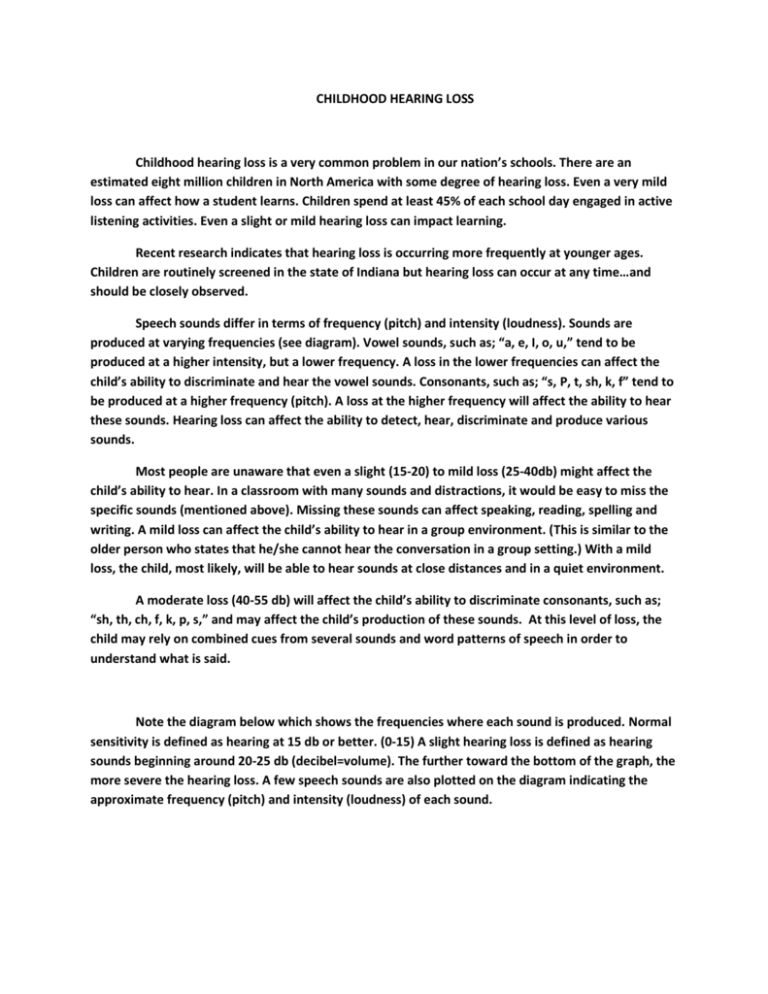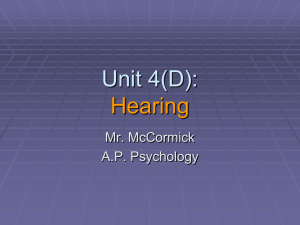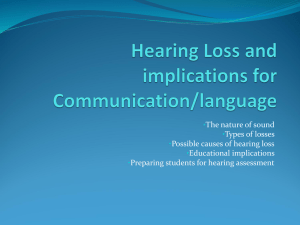Childhood Hearing Loss - Wa
advertisement

CHILDHOOD HEARING LOSS Childhood hearing loss is a very common problem in our nation’s schools. There are an estimated eight million children in North America with some degree of hearing loss. Even a very mild loss can affect how a student learns. Children spend at least 45% of each school day engaged in active listening activities. Even a slight or mild hearing loss can impact learning. Recent research indicates that hearing loss is occurring more frequently at younger ages. Children are routinely screened in the state of Indiana but hearing loss can occur at any time…and should be closely observed. Speech sounds differ in terms of frequency (pitch) and intensity (loudness). Sounds are produced at varying frequencies (see diagram). Vowel sounds, such as; “a, e, I, o, u,” tend to be produced at a higher intensity, but a lower frequency. A loss in the lower frequencies can affect the child’s ability to discriminate and hear the vowel sounds. Consonants, such as; “s, P, t, sh, k, f” tend to be produced at a higher frequency (pitch). A loss at the higher frequency will affect the ability to hear these sounds. Hearing loss can affect the ability to detect, hear, discriminate and produce various sounds. Most people are unaware that even a slight (15-20) to mild loss (25-40db) might affect the child’s ability to hear. In a classroom with many sounds and distractions, it would be easy to miss the specific sounds (mentioned above). Missing these sounds can affect speaking, reading, spelling and writing. A mild loss can affect the child’s ability to hear in a group environment. (This is similar to the older person who states that he/she cannot hear the conversation in a group setting.) With a mild loss, the child, most likely, will be able to hear sounds at close distances and in a quiet environment. A moderate loss (40-55 db) will affect the child’s ability to discriminate consonants, such as; “sh, th, ch, f, k, p, s,” and may affect the child’s production of these sounds. At this level of loss, the child may rely on combined cues from several sounds and word patterns of speech in order to understand what is said. Note the diagram below which shows the frequencies where each sound is produced. Normal sensitivity is defined as hearing at 15 db or better. (0-15) A slight hearing loss is defined as hearing sounds beginning around 20-25 db (decibel=volume). The further toward the bottom of the graph, the more severe the hearing loss. A few speech sounds are also plotted on the diagram indicating the approximate frequency (pitch) and intensity (loudness) of each sound. The effects of a slight hearing loss are subtle, but may include difficulty in: o o o o o o o o Hearing faint/distant speech (distant greater than three feet Hearing the fine distinctions in words sounds, such as the “s” in plurals Difficulty hearing the “s” in possessives (Tommy’s hat) Difficulty hearing the tense words ( is /was, fill/filled) Difficulty hearing with background noise interference (classroom) Difficulty following a fast-paced conversation) Difficulty picking up the subtle conversational cues Difficulty focusing on what the teacher is saying in a noisy classroom Your child might experience problems like these: o o o Hard to hear the teacher if not sitting close to teacher Extremely tired after school (from intense work to listen/hear) Inappropriate response to question (child misunderstood question) Things parents can do to help child and the teacher: o o o Tell teacher about the hearing loss Ask for seating close to the teacher Ask teacher to face the child when speaking o o o Make sure the child sits with “good” ear nearest the teacher Teach the child to ask teacher to repeat if message unclear Monitor ear infections, coughs, complaints of ear ache Things teachers can do to assist the child and parents: o o o o Alert parents if child appears to miss information Alert parents if child responds inappropriately Alert parents if child complains of sore throat, ear ache Alert parents if child appears to “space out” Remember, hearing loss may not be immediately obvious. The child may not be aware of any problem. Adults must be observant and watch for symptoms that may occur. Cheryl Hodges-Stillson M.A., C.C.C., S.L.P. 10/26/09








